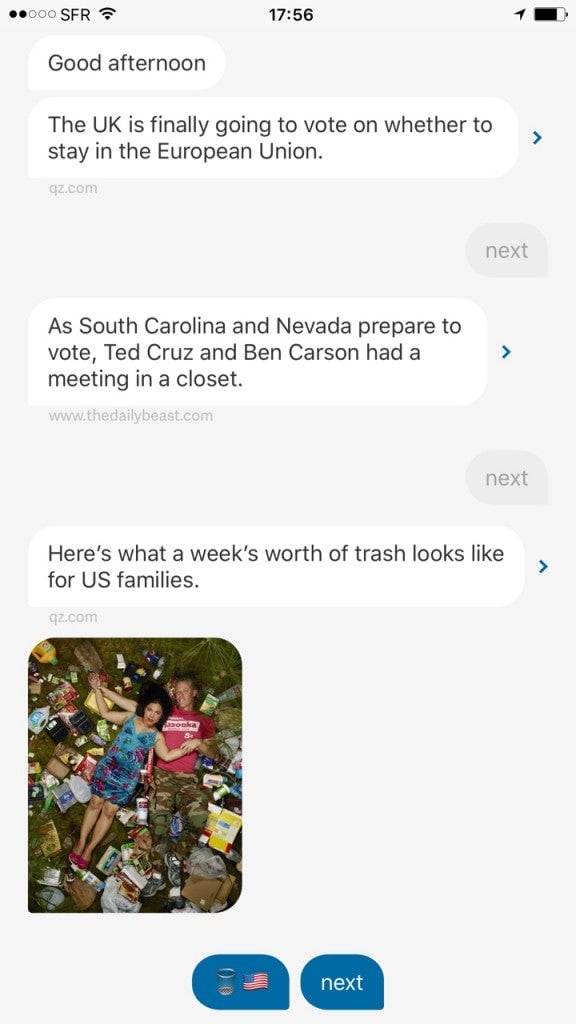Can robots save the news?
Great news content is no longer enough. No serious publisher can expect growth or monetizable loyalty without adding a layer of services that generate reader stickiness. This is the vision shared by the most sophisticated segment of the publishing world. And yet, to my dismay, I keep bumping into news providers (often established, legacy players) still obsessed with stuffing mobile pages with interstitials and auto-play videos. For these, days are numbered. The herd will get thinner.


Great news content is no longer enough. No serious publisher can expect growth or monetizable loyalty without adding a layer of services that generate reader stickiness. This is the vision shared by the most sophisticated segment of the publishing world. And yet, to my dismay, I keep bumping into news providers (often established, legacy players) still obsessed with stuffing mobile pages with interstitials and auto-play videos. For these, days are numbered. The herd will get thinner.
Forward thinkers see the following forces in play:
- In the long run, big newsroom investments, hiring the best talent money can buy, and devising the cleverest packages won’t be enough to grow readership.
- There is no end in sight for business model struggles. Making readers pay is extremely difficult; it requires the deployment of truly unique (and costly) editorial contents—an option reserved to only a handful of publishers. As for the free, ad-supported model, it is also in jeopardy because audiences migrate en masse to mobile where monetization is thin.
- Going full-steam ahead to social looks fine. But once publishers realize they have surrendered their distribution channels (see last week’s piece about social-driven unicorns), social might feel like golden handcuffs—plated ones.
- We need to become indispensable to our readers as a way to address audience leakage caused by social and aggregators.
These are the reasons why everyone is considering new sets of value-added services. Some envision building smart aggregators whose content will get a seal-of-quality granted by media brands—it could work, even if it sounds a bit pretentious. Many regret having missed other paths, like the one paved by the oft-mentioned Nuzzel (see a recent Monday Note about this sophisticated aggregator).
A small set of players are projecting themselves a step further, wanting to completely rethink the relationship between media and readers/users.
Today, reader interaction is mostly based on push mode. The publisher sends all sorts of news on its platforms (website, apps) and on third-party social channels: basic ones involve Facebook and Twitter, others spread their stuff over 20 platforms—most of the time without direct monetization.
Relying on bots could reverse the process. There are two categories of bots: transactional and conversational. Applied to news, the transactional bot is pretty crude, but it could work like this:
“Hey, get me the latest news about Apple vs. the FBI.”
The bot then would tap into aggregators such as Google News, or into a predetermined set of publications the creator would have painstakingly pre-entered. Unfortunately, chances are that, in my 3 am reading, I’d have already ingested a great deal about Tim Cook’s not-so-futile resistance. In that example, the filter is dumb. It is either too large and will deluge me with useless stuff, or too narrow, unable to build upon my interests and provide me with truly novel, unseen pieces of information that might reside outside of my usual perimeter.
In fact, the transactional bot is no more than a digital assistant dedicated to search. The input could be textual, like this, borrowed from the Quartz mobile app which mimics text messaging:

…or it could be a vocal, if I’m at home or in my car and I talk to my phone. If it to boils down to that, I better stick to a well-arranged RSS Feed, or to a Nuzzel-like service in which my social sphere acts as curator.
Such “transactional bots” need to be supplemented by a much more sophisticated iteration with a “conversational bot” that knows a lot about me and never forgets anything.
It could work like this:
At 7 am, when I’m caffeinated and ready to start, or after a day of work which kept me away from the news cycle, I reconnect and my InfoBot says:
“Hey Frederic, while you were away, I got this for you: The fight between the FBI and Tim Cook is heating up. You might want to look at this Washington Post editorial, at a NYTimes legal analysis, and a technical piece about encryption in The Intercept. Which one do you want?”
“Get me the Post editorial and The Intercept thing. What else?”
“I have the latest filing issued Friday by the US Attorney—a 35-page PDF. Do you want me to download it to your devices?”
“Yes, get it. What’s new on the election?”
“Donald Trump criticizes the Pope, keeps insulting Megyn Kelly, and leads in the polls by 18 points.”
“Maybe later. Find me a long read for tonight.”
“Vanity Fair has a long piece titled the ‘The Tech Bubble’s Short-Sellers,’ and there is one in Nature by Vilayanur Ramachandran about PTSD. The VF issue is $4.99, the Nature piece is $1.50. Shall I proceed?”
“OK, get me both. What else might you have?”
“Michael Lewis’ next book is available in pre-order on Amazon. Interested?”
“Send me the summary first.”
“OK, will do. There is also a developing story in Iran: the creators of the Gershad application have been arrested. I found a short note on Al Arabya.”
“The Gershad app? What’s that?”
“You read a story in Wired titled: ‘In Iran, youth rely on a Waze-like app to evade the morality police.’ You shared it.”
“Oh, yes! Follow that please. And send the link to (…)”
At this point, it gets interesting because each of the following are features in the bot’s toolbox:
- NLP (natural language processing) to understand requests and shoot back responses.
- Finding items I didn’t view, meaning it keeps tabs on my reading lists.
- Assessing the depth of my interest in a subject. Yes, I’m actually interested in reading Justice Department filings about Apple. But I’ll be more superficial about the primary in South Carolina.
- It remembers my centers of interest not as a set dumb of averages, but weighed within the news cycle’s context, or outside of it. For example, it knows I’ve read most of the articles and books written by Michael Lewis, and also that I’m interested in neuroscience to the point that I shared lectures by Harvard’s professor Vilayanur Ramachandran a couple of years ago.
- It makes a selection based on story length, relevancy, freshness.
- It taps into my subscriptions and, on my behalf, performs occasional purchases.
- It detects low-noise topics and guesses my interests in those. The courageously “subversive” Gershad app is not at the top of news, but it’s on my own radar.
- It connects to other services I use—mail, note-taking apps, or collaborative tools like Slack where I’ll share material with my team.
For this, technologies already exist … to some extent. They need to be harnessed together, which is not a small task. Several large players are already on it, such as Google Now and Microsoft Cortana, advancing with prudent steps. iPhone’s Siri opts for a different path: It’s a “stateless” app—no background, no memory, and it doesn’t use any dataset about me (aside from my vocal patterns).
Two questions in conclusion for today:
One: How could a bot be made to suggest, recommend, or guess what’s best for me? The short answer is “profiling” and “opt-in.” The long answer will be outlined in next week’s Monday Note. Let’s just say these two items are critical to the future of news publishing.
Two: Who should build such an InfoBot? For publishers, it could become a game changer. But for cultural, competitive, and financial reasons I don’t see any of them going for it. The Washington Post, funded and technology-infused by Jeff Bezos, is a possible exception. More realistically, I would lean towards a tech-oriented pure player approaching the news business from the technology side. A Nuzzel-like organization, maybe, with $100 million in funding.
This post originally appeared at Monday Note.